This past October, I spent 18 days exploring the mythical and vast territory of Patagonia. Patagonia covers one half of Chile and one third of Argentina. I only scratched the surface of this enormous region of South America, but my short visit was enough to leave me wanting more, much more. During my Patagonia escapade I hiked in the epic Torres del Paine National Park, visited the colossal Perito Moreno Glacier, explored the iconic hiking trails in El Chaltén, and concluded my Patagonia adventure with a visit to the Argentinian mountain town of Bariloche.
This post focuses on my visit to Torres del Paine National Park. Please visit my next blog post for tales and recommendations from my Patagonia Adventures (Part II).
Torres del Paine National Park
Torres del Paine National Park (“Torres del Paine”) is Chile’s most famous national park and is home to arguably the most famous multi-day trek in the world. The park is located in the southern portion of Chilean Patagonia and receives a staggering 250,000 visitors each year. I traveled to Chile without an itinerary, my only priority was making it to Torres del Paine. After exploring Santiago, Valparaíso, and Atacama, all located in northern Chile, I journeyed from the top of Chile to the deep south of the country, not far from Antarctica, to visit Torres del Paine. Fun fact: Chile is the longest country in the world, spanning 4,620 km (2,650 miles).
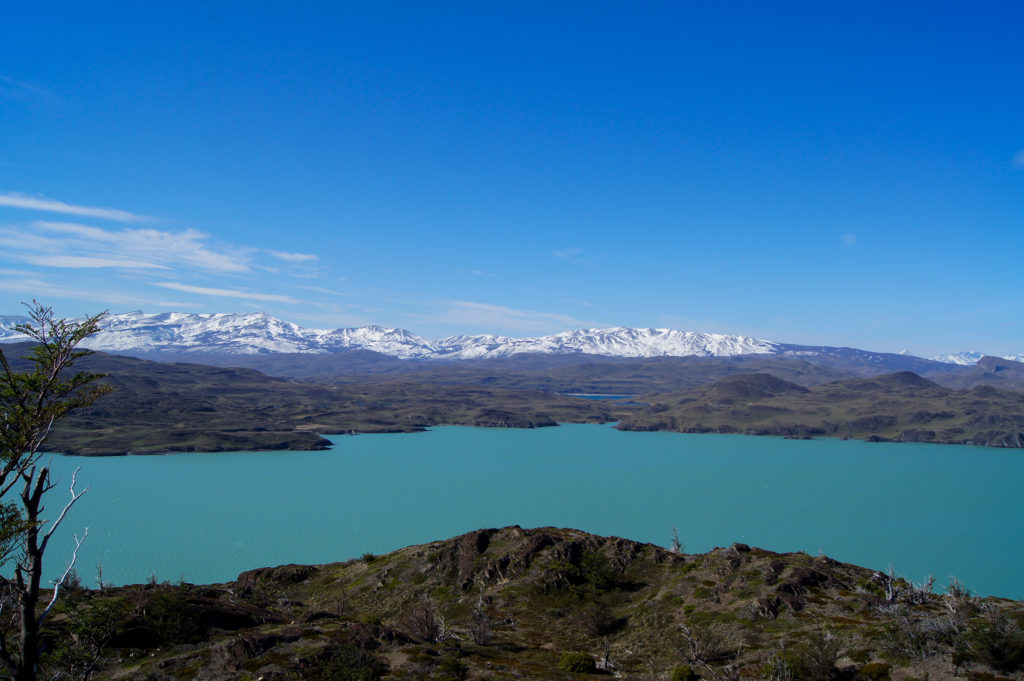
Puerto Natales, the Underrated Gateway Town to Torres del Paine
Although I was already in Chile, it took me an exhausting full night of travel, which included an hour van ride, two flights totaling six hours, a four hour layover, and a three hour bus journey, to get from the Atacama desert down to Puerto Natales. Puerto Natales is a colorful port town that is commonly used as a base for excursions to Torres del Paine. The moment I stepped off the bus, Patagonia greeted me with an invigorating gust of Patagonian wind.
I spent three memorable days in Puerto Natales, two days prepping for the Torres del Paine Classic W trek and a full day recovering post-hike. Pre-hike, I spent much of my time raiding grocery store shelves for popular trail food, like peanut butter (“mantequilla de mani” in Spanish) and searching outdoor camping stores for the perfect trekking layer (“¿Puedo probarme esta camisa con mangas largas de merino wool?” (“Can I try on this long-sleeve shirt made of merino wool?”). I spent the rest of my time in the city: wandering and exploring the town; practicing my Spanish in the shops; visiting tasty Chilean restaurants; walking along the harbor at sunset; reading my book in the park; and visiting a local gym. The town caters to hikers and many visitors are so caught up in prepping for their hike, they fail to appreciate the town’s charming people and natural beauty.
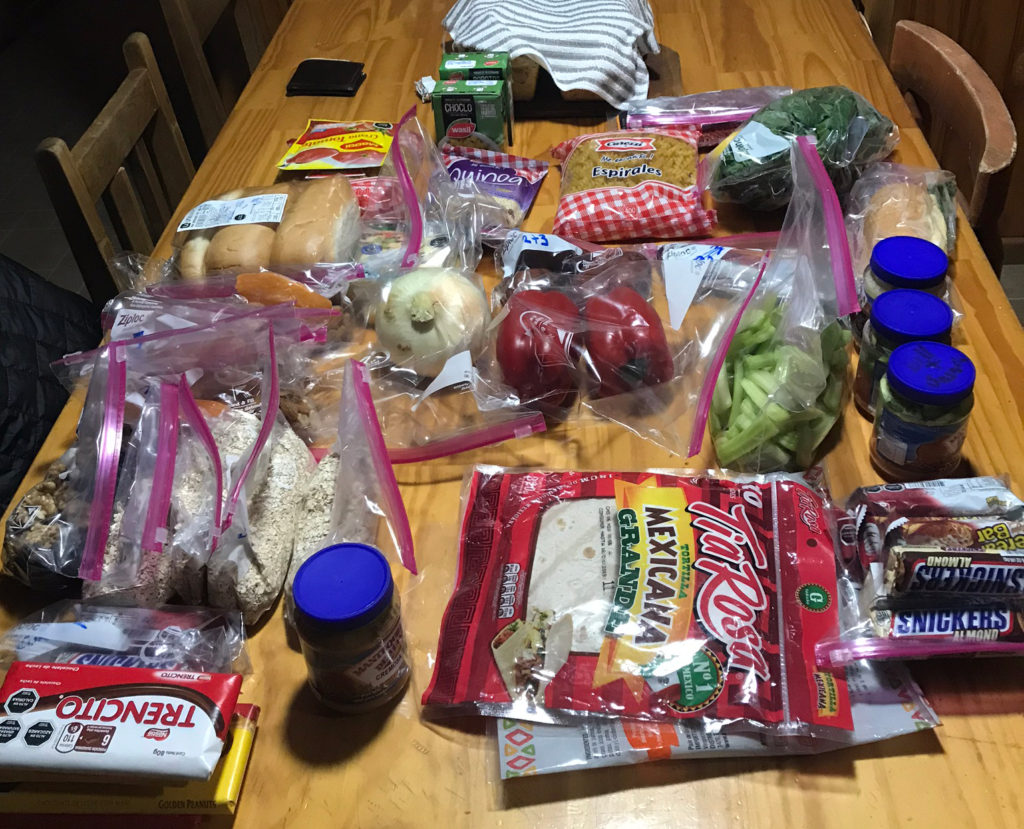
Puerto Natales Expert Tips
- Stay at the Erratic Rock Hostel, a cozy, creaky, cabin-like hostel, where you can rent any gear you need at the lowest prices in town. The owner is an amicable Patagonian lover, who is an incredible source of trekking advice. The free home-made bread is icing on the cake. Also, the hostel allows you to leave behind and lock-up any clothing or items you do not wish to lug on the hike. There are not many beds, so remember to book in advance!
- Day Zero Outfitters offers a free daily information session, and as a novice multi-day trekker I found it helpful in prepping for the trek.
- If you want to fill up on some large meals before the hike, I recommend La Picada de Carlitos for classic Chilean food and Base Camp for some hearty burritos. My favorite restaurant in town was Cafeteria Cangrejo Rojo. This hidden gem was recommended to me by a local, and it is a great place to get a tasty Chilean meal to celebrate once you have completed your big hike.
- ExtraFit Paddle & Gym is a terrific, spotless, and inexpensive new gym in town if you want to put on some upper body muscle to balance out those powerful new Torres del Paine thighs.
My Journey on the W Trek in Torres del Paine
In mid-October, I hiked the Torres del Paine W trail from west to east in 4 nights and 5 days. I began the hike solo, but I made many friends along the trail, and these friends made the experience a truly remarkable one. Shout out to Felix, Jelle, Hailey, Doug, and especially Kate. I had never done a multi-day hike where I was solo, carried my own pack, and cooked my own food. The experience was liberating and fueled me with confidence.
My Ode to Torres Del Paine
Especially in the beginning, I felt the park was testing me, evaluating my resolve and spirit, to see if I deserved access to its unrivaled unspoiled beauty. As I trekked across its windswept plains, along its endless turquoise lakes, and among its towering granite massifs, I felt the park was daring me to feel lonely and small. Seeming to act according to the park’s wishes, the Patagonian spring weather ambushed me with biting winds and blinding snow, an artifice aimed to diminish my existence. The park’s scare tactics proved useless; instead, while conquering its rugged terrain and enduring its severe weather, I absorbed the breathtaking views and found solitude, peace, strength, appreciation, and energy. For the final two days, the park rewarded me, the weather cleared and the park revealed the shockingly beautiful tapestry of its terrain in all its glory.
Day 1: Travel to park, hike from Paine Grande campsite to Glacier Grey campsite
It was long morning of travel before we (me and my fellow hikers) made it to the start of the trail. I was greeted with a remarkable scene when I arrived at the Puerto Natales bus station at 6:30 am: 30+ hikers of all ages, backgrounds, and nationalities, sagging under the weight of enormous backpacks of varying colors, shapes, and sizes, descended upon the bus stop from all directions. We patiently endured, a two hour bus ride, park entrance ticketing queue, hour wait at a café, and thirty minute Catamaran ferry ride, before we finally arrived at Paine Grande campsite, to begin the hike.
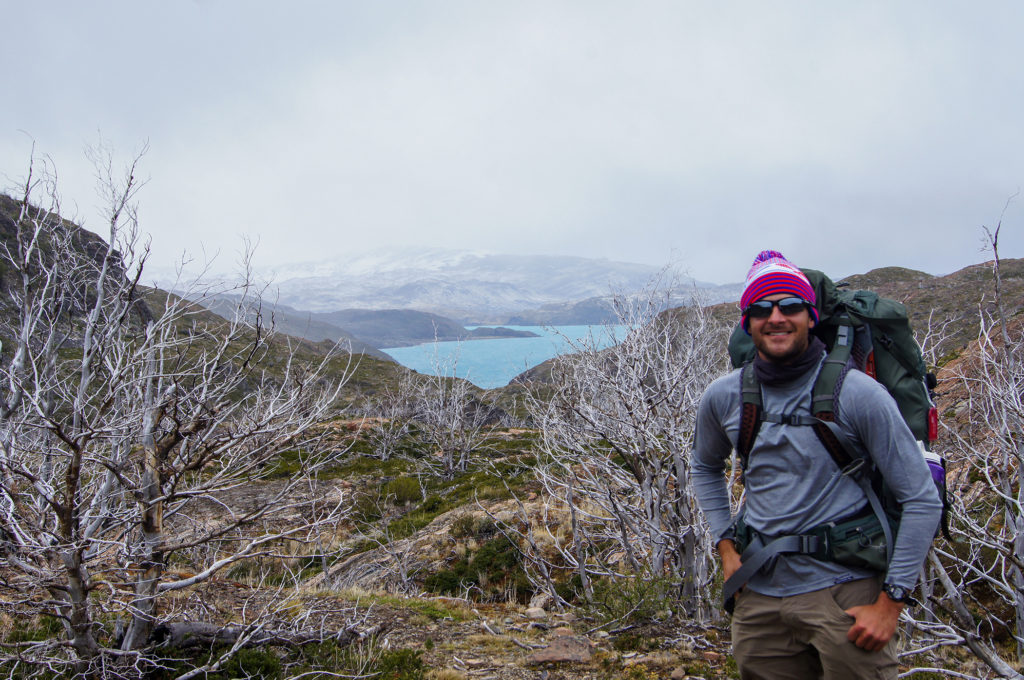
On Day 1 the visibility was poor with fog, clouds, light snow flurries, and sporadic rain showers obstructing our view for the majority of the day. We put our heads down, gritted our teeth, and pushed on against the heavy winds, making our way north along the edge of Lago (“Lake”) Grey to the first campsite.
Day 2: Hike to Glacier Grey viewpoint, hike from Glacier Grey campsite to Paine Grande campsite
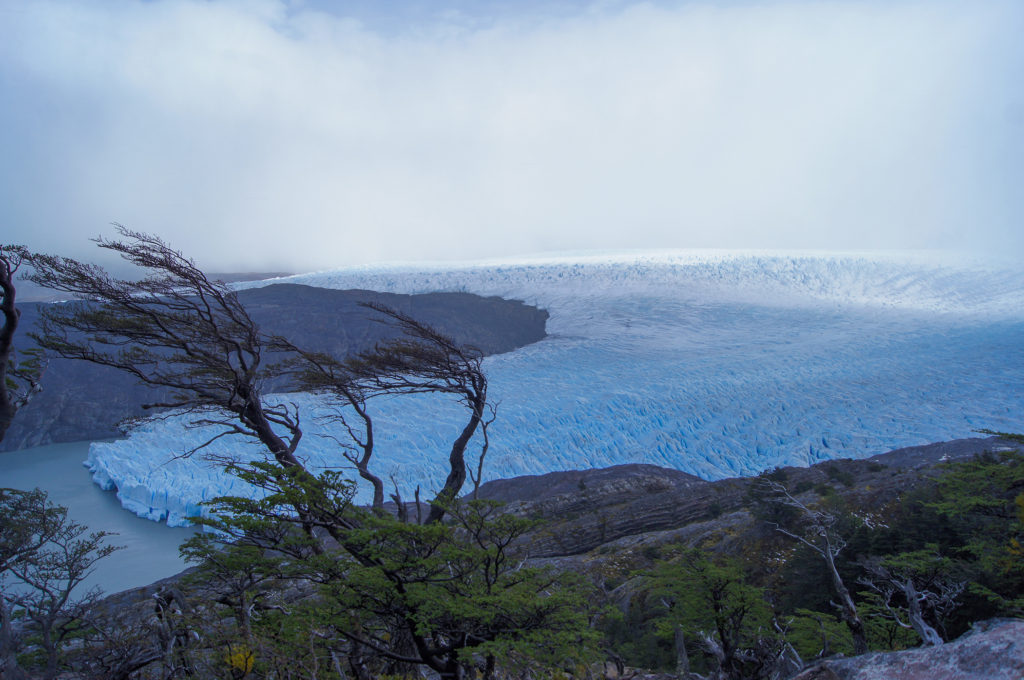
My BigFoot Kayak adventure out to Glacier Grey was cancelled due to heavy winds. In leiu of the kayaking, I headed north, on foot, to get a better view of Glacier Grey. I hiked across two entertaining, long, and wobbly suspension bridges and was rewarded with a stunning aerial view of Glacier Grey. The visibility improved significantly from the prior day, but the wind was fiercer. I turned around and began the hike to our second campsite. At first, I laughed out loud as gusts of wind literally propelled me along the trail. I abruptly stopped laughing when, at one point, the wind nearly sent me flying over the edge of the cliff into the lake.
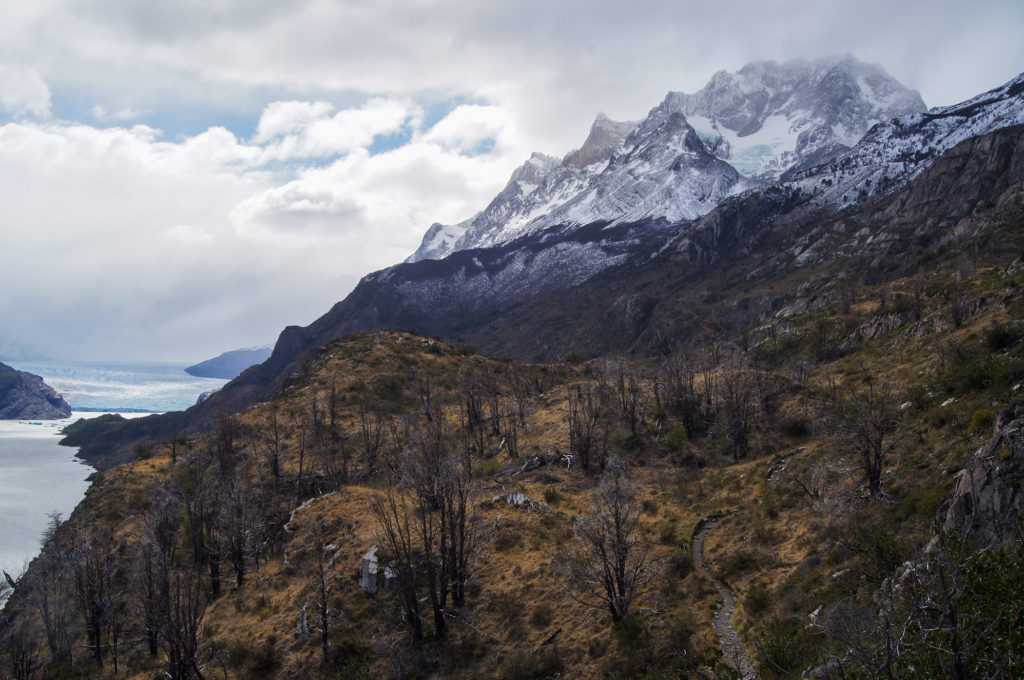
Day 3: Hike to Mirador Británico lookout, hike to Frances campsite
We had already experienced fall in the park, today it was time to hike through winter conditions. When confronted with a blizzard and all of the other hikers, one by one, turned back, I continued on, determined to make it to the Mirador Británico lookout. I carefully ascended the steep icy boulders and scree, jogged through a forest of slippery knee-high snow banks, and trudged up the final hill to the viewpoint. Unfortunately, there was not much too see through the veil of frenzied snowflakes. Nonetheless, I made snow angels in the snow to celebrate the success of my conquest.
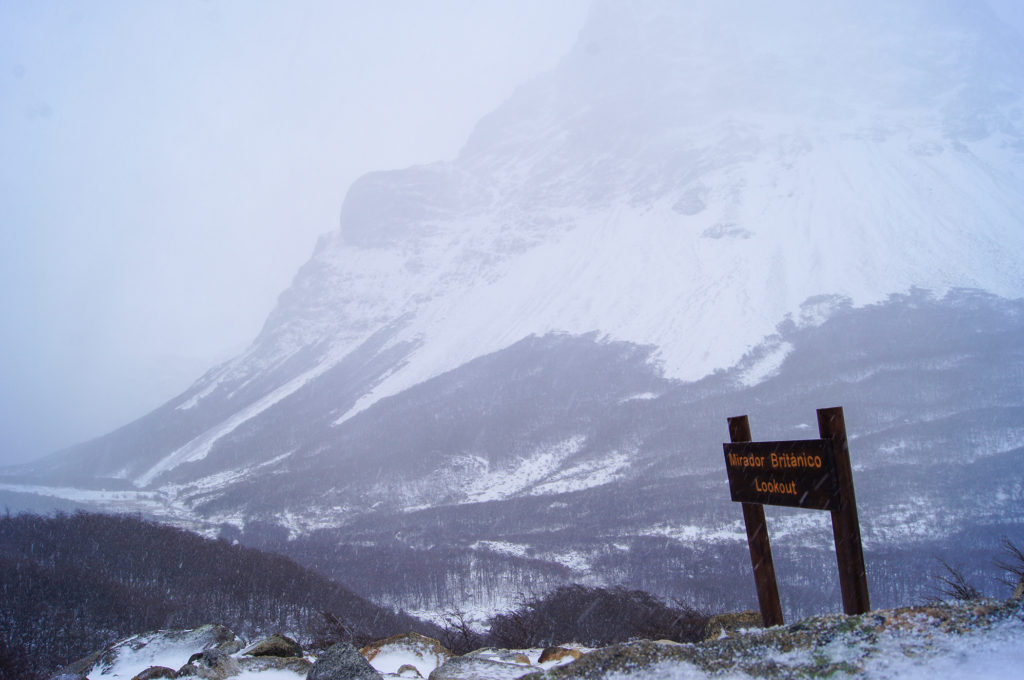
I spent the return hike walking alongside and enjoying the company of my Chicago friends, Kate, Doug, and Hailey. For the last three days, it became my routine to hike the first portion of the trail largely on my own and then hike the later half with this crew.
Day 4: Hike to Chileno campsite
Now, it was our time to experience spring and summer in the park. For the first time, a completely unobstructed sun welcomed us. We put on our shades, rolled up our pant legs and shirt sleeves, and let the sun’s rays thaw our still frozen limbs.
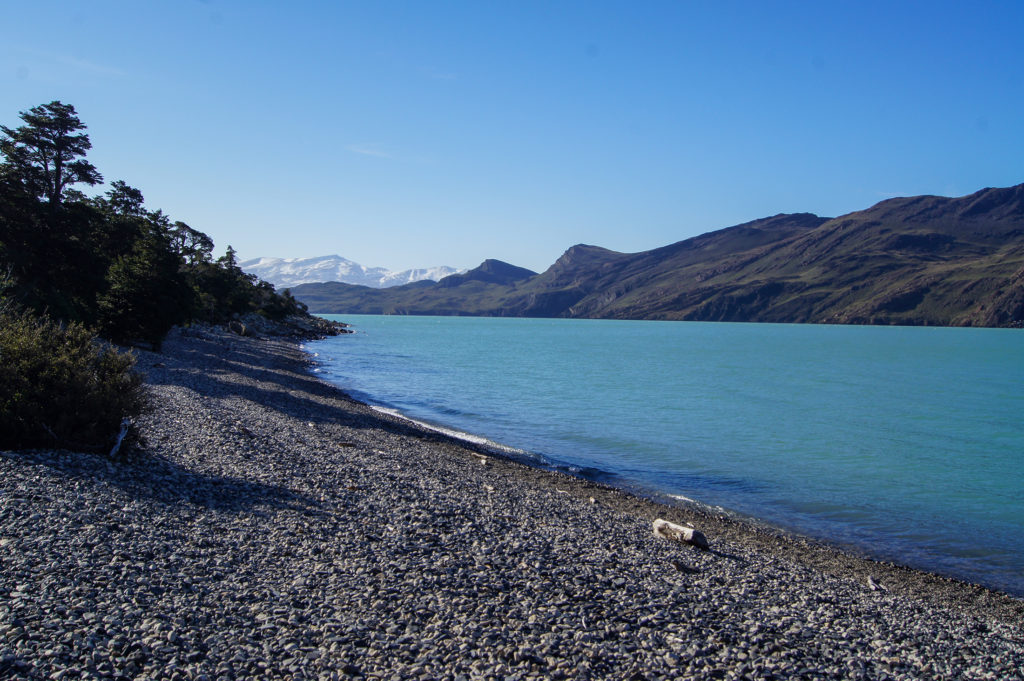
The trail snaked its way down and then along Lago Nordenskjöld. For one section, we walked along its rocky shores and gazed out at its turquoise waters, as waves gently washed ashore. Facing in the opposite direction of the lake, past the loose rocks, alpine bushes, and a cascading waterfall, the incredible Cuernos del Paine, with its exposed bands of granite, burst from the terrain with its jagged tops piercing the immaculate royal blue sky.
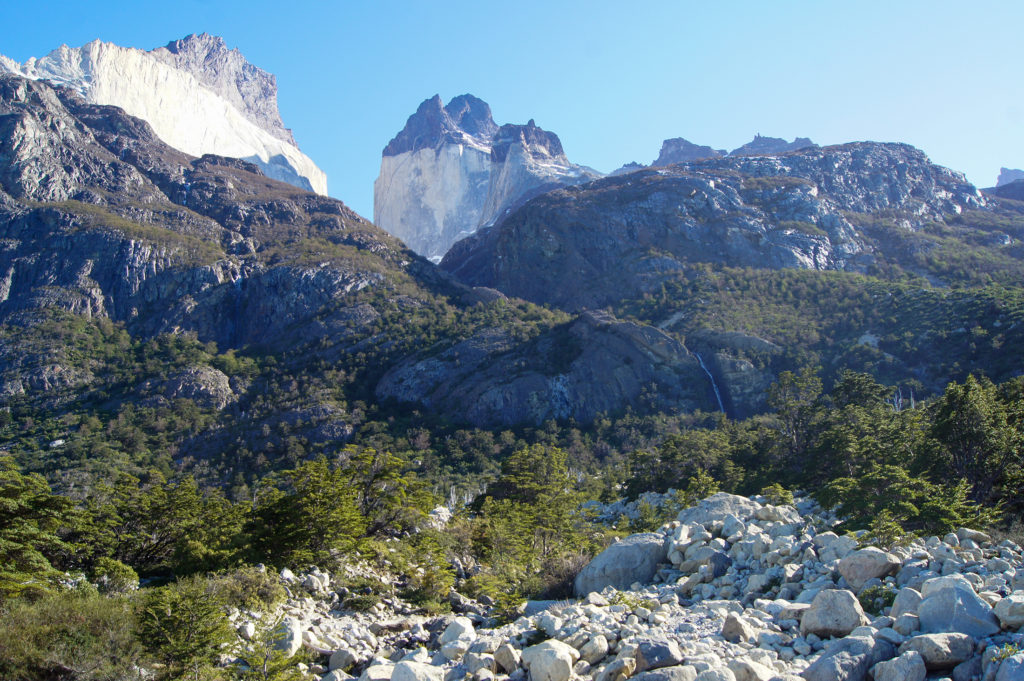
The weather was so inviting and the 360 degree views so mesmerizing, I couldn’t resist laying down in a field of grass for an hour break before joining my hiking friends for the rest of the day’s trek.
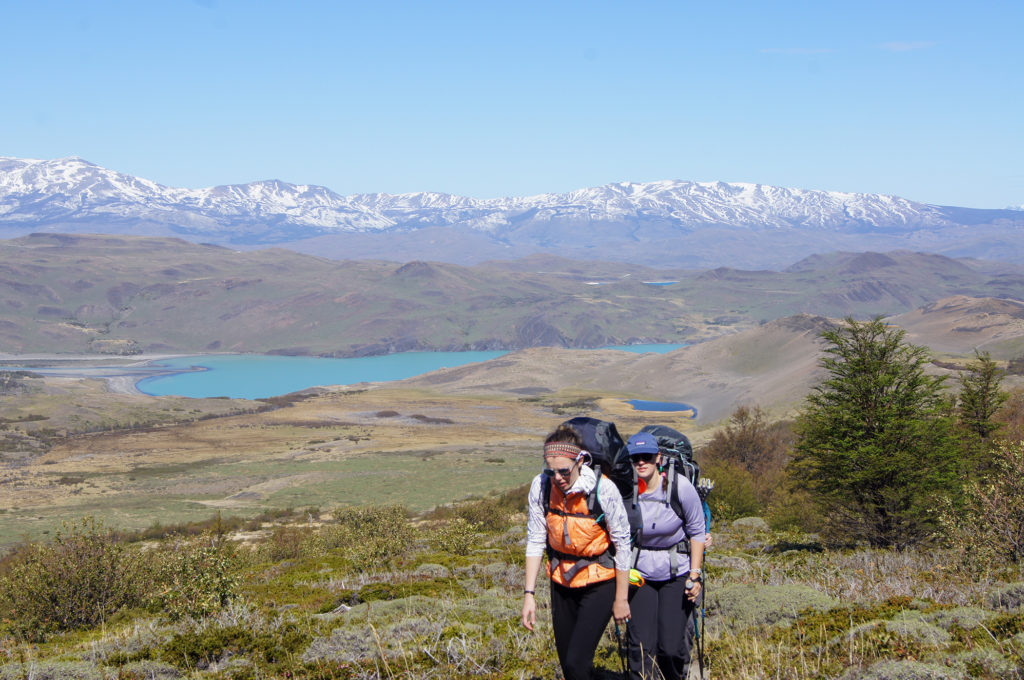
Day 5: Hike to Torres del Paine towers, hike to El Central, bus to Puerto Natales
I woke up at 4:30 am, slurped down my daily ration of oatmeal, and set out for a sunrise hike to the Torres del Paine towers. I felt light without the burden of my pack, and I was energized knowing that I would soon get a view of the park’s famous towers. I felt like jogging, and aided by the light from my headlamp, I navigated my way through the dark and up the mountain. As I passed hikers, I handed out chocolate to motivate and celebrate our progress. Yes, I’m ridiculous sometimes.
I was the first to summit and I’ll never forget the site behind me: dozens of evenly-spaced, bobbing headlamps, floated in a spiral procession up the steep mountain trail.

I soon arrived at the magnificent ice-glazed lake that sits at the base of the granite towers, and, shivering from the cold, I waited patiently for the towers to radiate a molten orange color known as alpenglow. Unfortunately, the rare natural occurrence was a no-show, but the view when the sun’s rays crested the horizon and illuminated the peaks met our nearly unattainable expectations.
After enjoying the view for as long as we could withstand the cold, we began the downward sloping journey home. One of my hiking friends had been running the entire trail with her husband, and I decided to join her, running with my pack for the final 3 kilometers. Some people are crazy, and I love it.
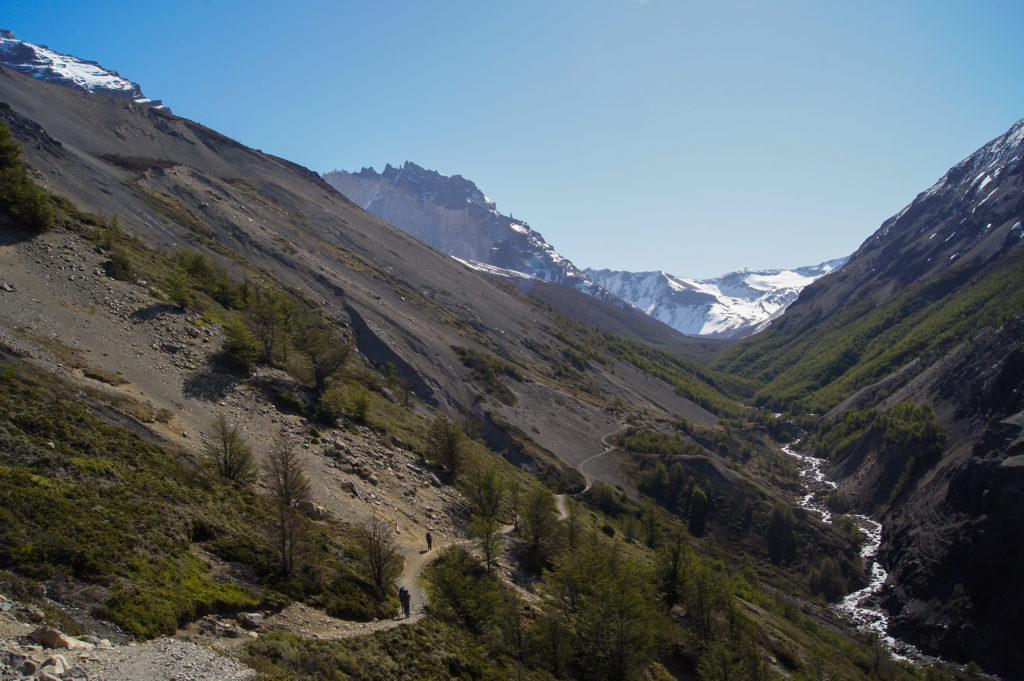
After completing the last leg of the hike, we all piled our fatigued, mud-caked, wind-battered, and bone-aching bodies into the bus. As we drove away, we were given a full, unobstructed view of Torres del Paine in the distance. When we had arrived, five days earlier, the sky was foggy, low sitting clouds enveloping the park, and we could not see anything past the thick coating of condensation that lined the bus windows. The now clear view of the park, with the Cuernos del Paine spiking up as a centerpiece, brought closure and confirmed what I had already known to be true, I had just spent the last five days hiking in one of the most beautiful places on the planet.
Torres del Paine Expert Tips
- You do not need a guide to walk the Torres del Paine W trail.
- Consider visiting Torres del Paine during the shoulder season in late October or early April. It’s a bit of a weather gamble, but being able to walk the trails without traffic is worth it. Remember, this is Patagonia, so no matter what time of year you visit you never know what kind of weather is in store.
- Book your accommodations in advance! If you plan to hike the classic trails (W or O trail) in Torres del Paine during peak season (November through March), you must book your park accommodations many months in advance.
- Consider going on a BigFoot Kayak excursion on Lago Grey to get up close to Glacier Grey. My kayak booking was cancelled due to the weather, but after seeing the icebergs on Lago Grey and Glacier Grey, I’m sure the experience would have been unforgettable. I recommend booking this in advance.
- Book cabins “refugios” along the trail, rather than campgrounds, especially if you are not a die-hard camper. I reserved a bunk in the refugio four out of the five nights of my trip, and one night I reserved a tent that was set up in advance of my arrival. It was nice not having to pack, carry, and assemble my own tent. A good night of sleep is worth the extra cost, and hikes are less fun when you spend half the night laying awake shivering. If you are cold in your tent, fill a Nalgene bottle with boiling water and put it in your sleeping bag. This tip is a game changer.
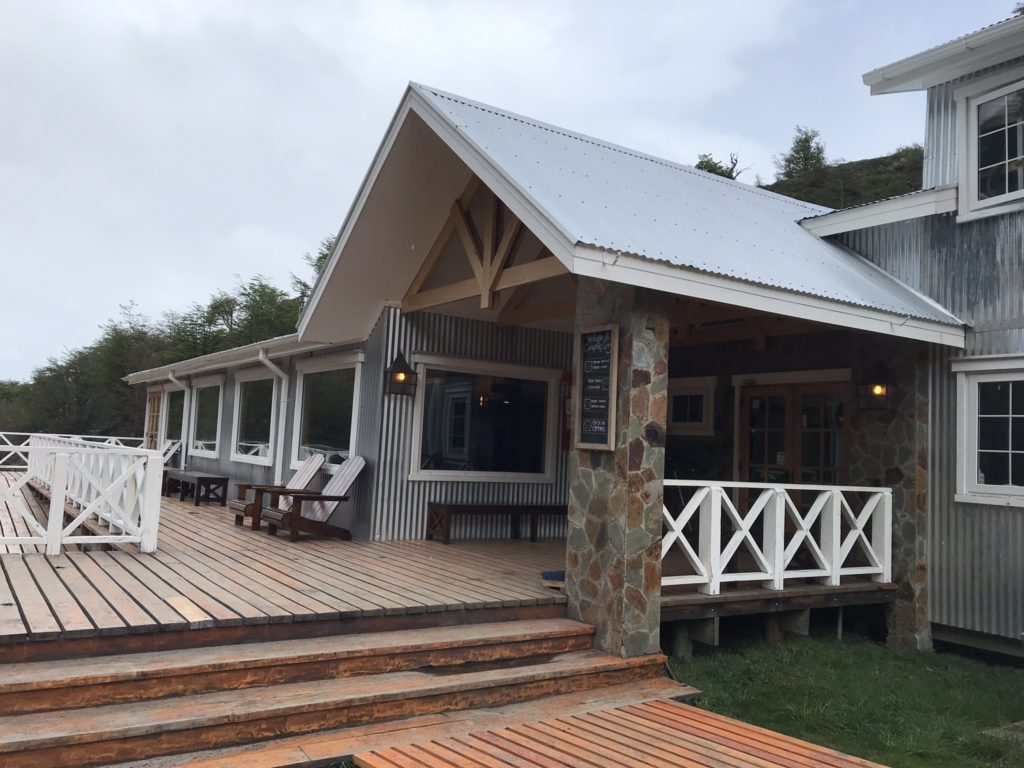
- Pack / cook your own food. There is an option to pay for boxed lunch and dinner at the refugios, but this option is pricey for backpackers. One of my favorite parts of each day was joining the other hikers and whipping up a tasty dinner. The kitchen was the best place to bond with fellow hikers and exchange travel tales.
Top Four Essential Gear Recommendations for Hiking in Patagonia
- Hiking boots. Quality, broken-in, hiking boots is a must. A few of my trail buddies were forced to turn back in the snow, because they were not properly equipped.
- Merino wool socks (with liners). All the hiking pros recommend merino wool socks to keep your feet warm and dry and to help prevent blisters. Sock liners are worn underneath your main hiking socks. The extra layer wicks away sweat and reduces friction, preventing blisters. Though I cannot guarantee it for others, I rocked this sock combo, and I did not get a single blister during the entire trek. I picked up my sock liners at a local REI store.
- Trekking poles. My favorite trekking poles are the Black Diamond Distance Z trekking poles, because they are stable but breakdown and conveniently fold up. The trails are steep and I found poles to be critical especially on the descent. With a heavy load on your back, when climbing down, you will be forced to load all of your body and pack weight on one leg. The poles help to distribute this weight and the added support can prevent nasty falls. One of my friends chose not to use poles and his knees were in severe pain on the last day of the hike. I used to laugh at trampers with poles but now I get defensive.
- Buff, sunscreen, polarized sunglasses. The depleted ozone layer in the southern latitudes close to the pole is no joke. The sun’s rays punish your skin and eyes even on hazy days. As I’ve noted in previous posts, I’m a die-hard Buff fan; it keeps you warm, protects your neck from the sun, and can be used to prevent the inhalation of dust and sand.
Disclaimer Regarding Affiliate Links
Article includes affiliate link(s). When a reader clicks one of these links and makes a purchase I receive a small commission, at NO cost to the reader. Anytime you click a link on my site and make a purchase please assume it is an affiliate link, and thank you for helping to support my blog. I only recommend products or services that I am familiar with and strongly believe in their quality and usefulness. When you click on an affiliate link on my site you can rest assured that I have taken the time to thoroughly evaluate and consider the product before recommending it! Cheers.

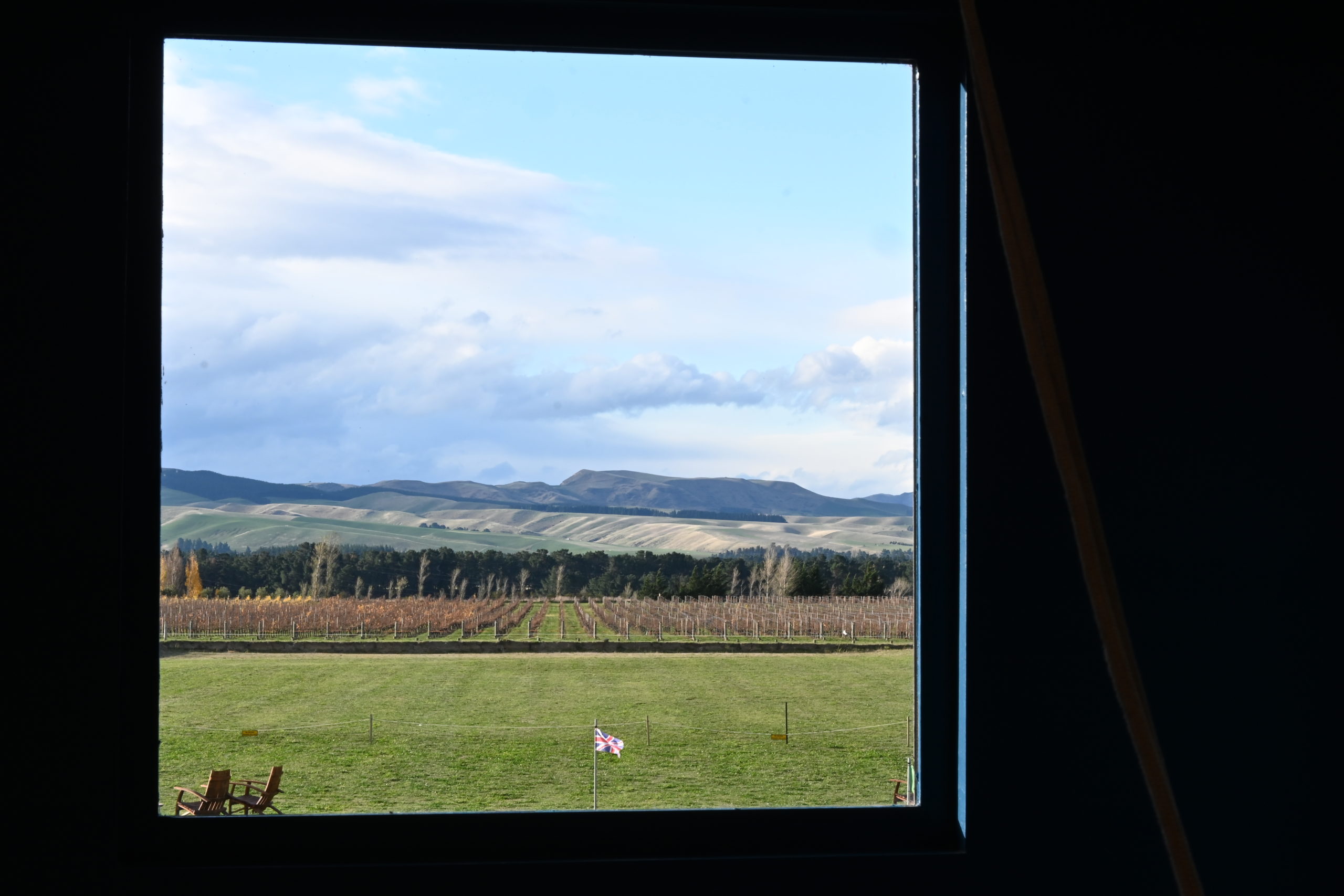
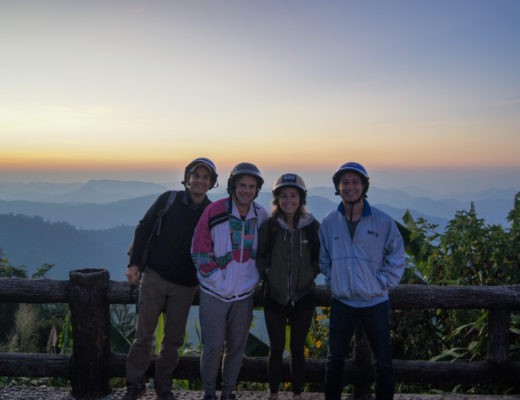
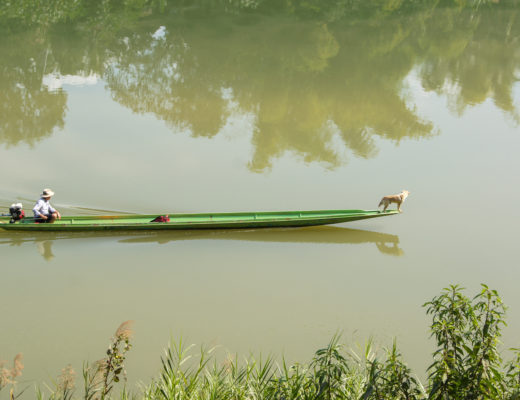
jtcombi
August 6 at 7:39 pmIt’s been a while! New post! Check it out!
John Combias
August 9 at 10:39 amGreat post T. What an experience. Spectacular photos.
jtcombi
August 10 at 8:46 amThanks so much for reading D! LT